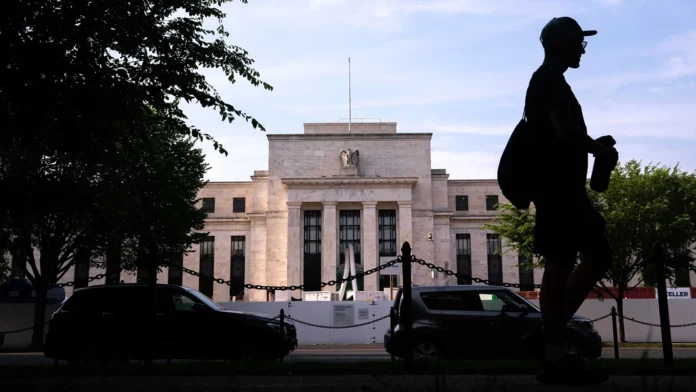The Federal Reserve received a clear signal to cut interest rates this month following a disappointing U.S. jobs report. On Friday, the Labor Department revealed that nonfarm payrolls increased by just 142,000 in August, a significant drop from the previous month’s upwardly revised gain of 89,000. Economists had anticipated a rise of 160,000 jobs, a forecast that followed a previous figure of 114,000 for July.
This disappointing data highlights a notable slowdown in job growth. The three-month average monthly payroll increase now stands at 116,000, which falls short of the 200,000 jobs per month analysts believe are necessary to keep up with current job-growth demands, particularly given the expanding population due to immigration.
Omair Sharif, President of Inflation Insights, sees this report as a strong indicator for the Federal Reserve to take action. He suggests that the Fed should consider a more substantial rate cut than originally expected. “Time to cut 50 bps,” Sharif stated, referring to his prediction that the Fed will implement a half-percentage-point cut at its meeting scheduled for September 17-18. This would be a more aggressive move compared to the smaller quarter-percentage-point reduction anticipated by many analysts prior to the report.
The need for a rate cut is underscored by the slowdown in job growth, which has become a critical factor in the Fed’s decision-making process. The current pace of job creation is insufficient to support the growing workforce, which has expanded partly due to increased immigration. This situation puts pressure on the Federal Reserve to adjust its monetary policy to stimulate economic activity and support employment.
The Federal Reserve’s decision on interest rates will be closely watched in the coming weeks. A significant rate cut could signal the Fed’s response to weaker-than-expected economic indicators and its commitment to bolstering economic growth. Such a move would aim to lower borrowing costs, encourage spending and investment, and ultimately support job creation.
The August jobs report also reflects broader concerns about the strength of the labor market. With job growth lagging behind expectations, the Fed faces a challenging environment as it weighs its policy options. The central bank must balance the need to stimulate the economy with the risk of potentially exacerbating inflationary pressures.
Investors and economists will be keenly observing the Fed’s actions and statements in the lead-up to the September meeting. The central bank’s response to the weak job growth data will play a crucial role in shaping market expectations and influencing economic conditions in the months ahead.
As the Federal Reserve considers its next steps, the August jobs report provides a critical backdrop. The slower job growth underscores the need for effective monetary policy to address economic challenges and support a healthy labor market. The Fed’s upcoming decision on interest rates will be a key factor in determining the trajectory of the U.S. economy and its ability to sustain growth amid shifting economic conditions.
The Federal Reserve has received a clear indication from the latest jobs report that it may need to take more decisive action to support economic growth. The disappointing payroll figures highlight a need for a more aggressive rate cut to address the slowdown in job creation and bolster the economy. As the Fed prepares for its upcoming meeting, the focus will be on how best to respond to the current economic challenges and support a stable and growing labor market.
The impact of a potential rate cut extends beyond immediate economic adjustments. Lower interest rates could influence consumer behavior and business investment. For consumers, cheaper borrowing costs might lead to increased spending on big-ticket items like homes and cars, which in turn could stimulate broader economic activity. For businesses, reduced rates can make financing expansion projects more attractive, potentially leading to job creation and innovation.
However, there are concerns about the long-term effects of such a policy shift. Critics argue that prolonged periods of low interest rates can lead to financial market distortions and asset bubbles. They suggest that easy monetary policy might encourage excessive risk-taking and contribute to financial instability. Additionally, if the economy overheats, the Fed may face challenges in managing inflation without resorting to abrupt rate hikes.
The Fed’s decision will also be influenced by other economic indicators and global factors. For instance, trade tensions and geopolitical uncertainties can affect the U.S. economy’s performance and influence the central bank’s policy choices. The interplay between domestic economic conditions and international developments will be crucial in shaping the Fed’s approach to monetary policy.
As the September meeting approaches, the Federal Reserve will need to carefully consider the broader economic context. While the August jobs report provides a compelling reason to consider a rate cut, the Fed must also weigh the potential risks and benefits of such a move. Balancing the need to stimulate growth with the necessity of maintaining financial stability will be a key challenge for policymakers.
Furthermore, the Fed’s communication strategy will play a vital role in shaping market expectations and public perception. Clear and transparent messaging about the rationale behind rate decisions can help manage market reactions and ensure that economic policies align with long-term goals. The Fed’s approach to communicating its policy stance will be closely scrutinized by investors, businesses, and policymakers alike.
The Federal Reserve faces a critical decision in the wake of disappointing job growth data. The potential for a significant rate cut reflects a response to weaker-than-expected employment numbers and broader economic concerns. As the central bank navigates these challenges, its actions will have far-reaching implications for the U.S. economy and financial markets. The coming weeks will be pivotal in determining how the Fed addresses these issues and supports economic growth amid a complex and evolving landscape.

